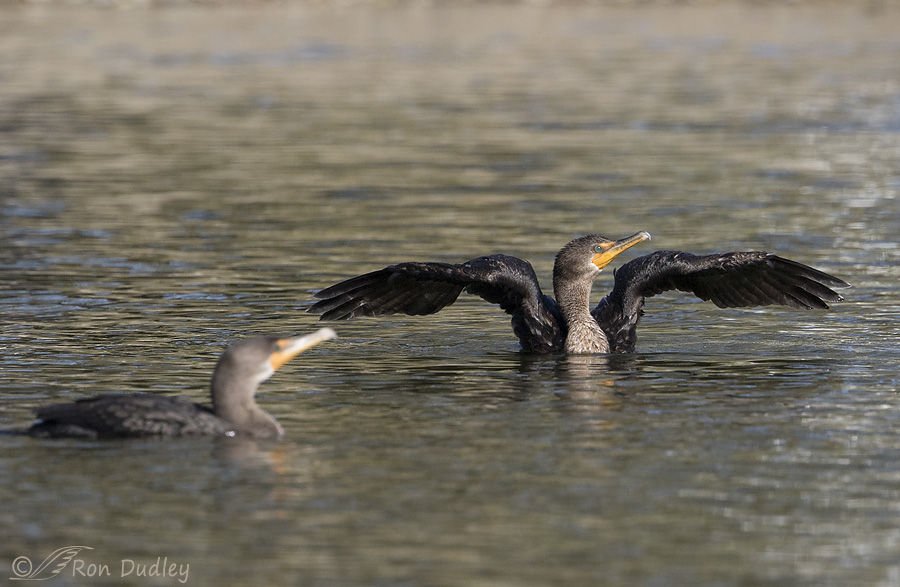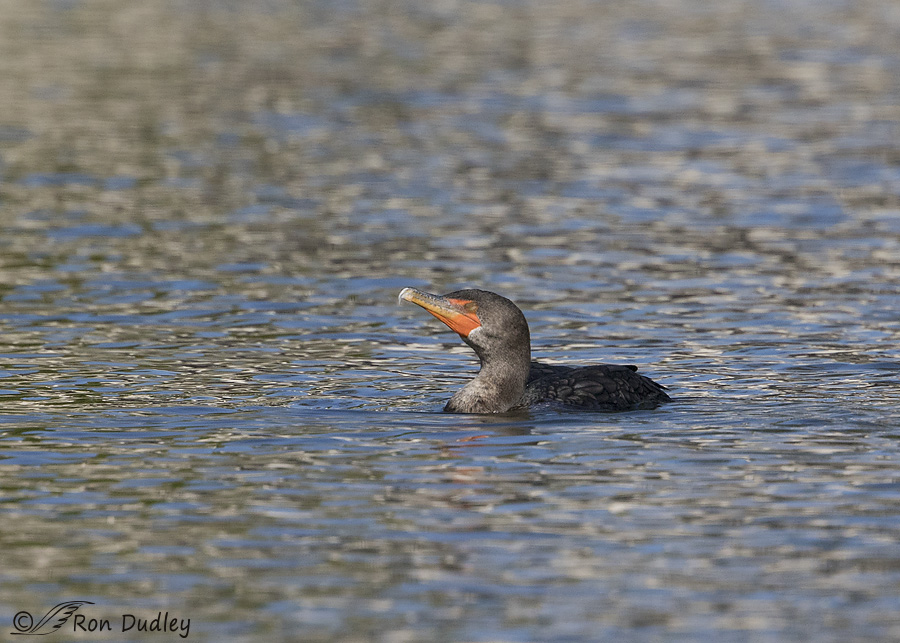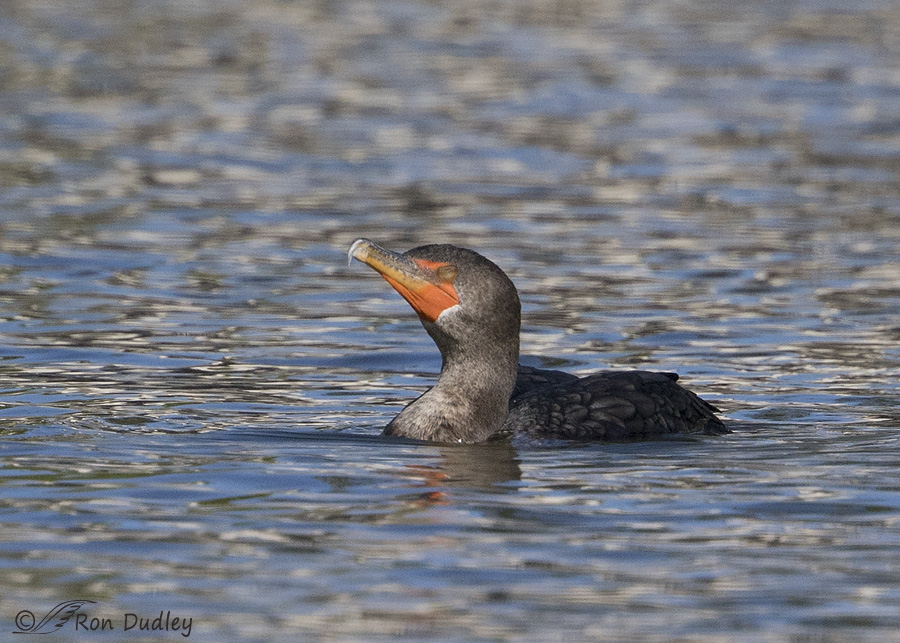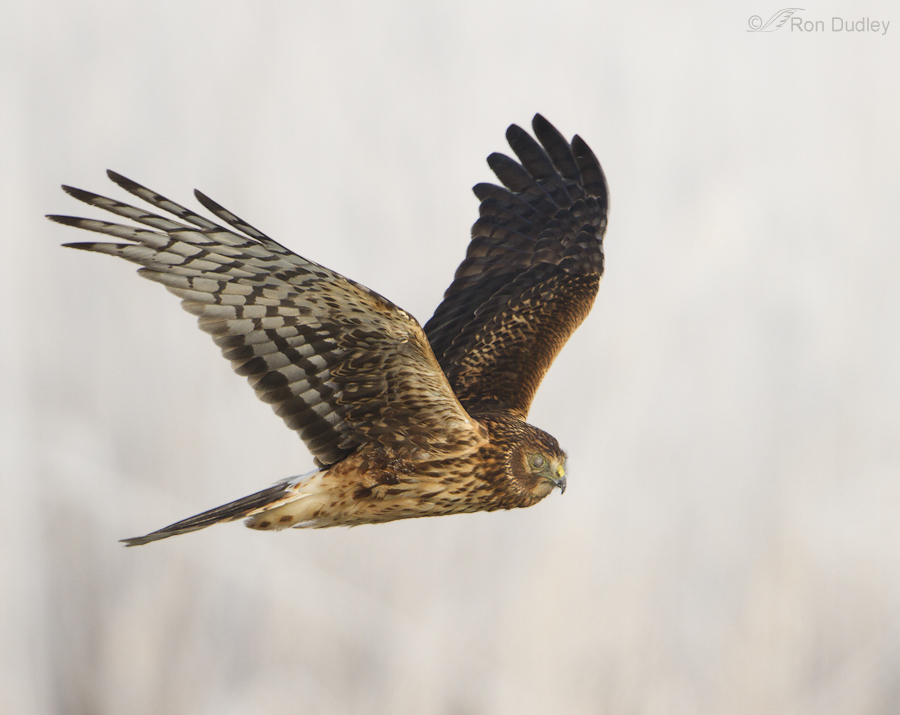This juvenile cormorant immediately caught my eye as being different from the others it was with.
Largely because of my daughter Shannon’s recent visit it’s been almost a week since I’ve been out shooting so after they left for home yesterday I made a quick trip to a local pond. On my last photo excursion my Canon 7D Mark II did something a little quirky with exposure for a few minutes and I wanted to check it out. While there I spotted a group of a half-dozen young cormorants that were too far away for quality photos but I fired off a few shots just to see if my exposure settings were working as they should (they were).
One of those cormorants immediately got my attention.

1/2500, f/6.3, ISO 500, Canon 7D Mark II, Canon EF 500mm f/4L IS II USM + EF 1.4 III Extender, not baited, set up or called in
Most of the juvenile Double-crested Cormorants looked exactly like I expected them to, including the yellow skin on the face and throat (gular region).

1/2500, f/6.3, ISO 500, Canon 7D Mark II, Canon EF 500mm f/4L IS II USM + EF 1.4 III Extender, not baited, set up or called in
But this bird, with its almost red gular region, stood out like a sore thumb. To the naked eye and through my viewfinder the color difference was even more dramatic than it appears here. Based on other physical traits I’m pretty sure this bird is a Double-crested Cormorant and not some other cormorant species not normally found in my area (northern Utah).
I might have just passed this off as normal color variation that occasionally occurs in populations of any species except for one thing – notice the eye of this bird. It looks really weird.

A huge crop gives us a somewhat better look at the eye. I took 14 photos of this bird and both eyes looked like this in all of them. I suppose it’s possible that the bird was simply sleeping with both eyes closed (I don’t know the normal color of their eyelids) but the coincidence with the eyes in combination with the unusual color of the gular region seemed too much to ignore and it piqued my curiosity.

1/2500, f/6.3, ISO 640, Canon 7D, Canon EF 500mm f/4L IS II USM + EF 1.4 III Extender, not baited, set up or called in
To be truthful the eyes of that cormorant immediately reminded me of the right eye of this Northern Harrier I photographed a few years ago at Farmington Bay. Only the right eye of this bird was involved so it could still fly and hunt but to this day I don’t know the cause of the anomaly.
Anyway, stuff like this gets my attention and arouses my curiosity so I just thought I’d throw it out there and see if any of my readers have any thoughts about what’s going on with the cormorant (or the harrier for that matter).
It makes me wonder if the unusual color of the gular region and the (apparently) unusual eyes may be somehow linked…?
Ron


Strange, re the cormorant, I thought of diet for the redness of the gular area, but the eyes… I wonder if the people at Cornell would know.It would be scary if it was adeformity due to a vitus or something that could spread. Time flies, was surprised your visit with Shannon is over already, but happy for you both that you had the time together
Without the bird in hand it is hard to tell what is up with the eye, but it does look odd.
It looks like it has a glaucoma, probably caused from an impact injury.
I’m glad you had a wonderful visit with your Daughter. I hope you can find out what is going on with the one bird. It has me worried.
Very interesting!super shots!
Charlotte
I hope you can find out.
I hope the bird can see. If it is indeed blind, then I cannot see how the blindness can be linked with the colour change.
Colour me clueless.
I am so glad you had your time with Shannon and her family.
Thanks, EC. We had a great visit.
Superficially, it looks to me like that Cormorant might be blind. A closer look at the crop seems like the eyes might be facing in a weird direction. I have never seen normal bird eyes that look like that. And my experience Cormorants is that they normally have very distinctive eyes, like the ones in the first photo. I’ll be interested to know what you find out about it.
“it looks to me like that Cormorant might be blind”
Could be, Susan. But then how it got to the pond becomes problematic. It’s a small urban pond and I don’t think it’s been there for long.
Speaking of the Harrier only, I wonder if the eye was injured and this is the result? Several years ago, Mariah (female redtail hawk), crashed into a glass wall chasing a rabbit on the other side and is now blind in her right eye. In the two years following her accident, a white-ish, opaque, almost-crystaline film formed just underneath the surface of most of her eye (film is not a real good word for that, but it’s not a cataract, either). But that’s just a guess. We’ll never really know…ah but the opportunity to wonder!
As for the cormorant, I got nuthin’!
I wondered about an eye injury on that harrier too, Laura.
I was talking about the Harrier only on my comment. It could also be the nictitating membrane with that bird, too, despite that it looks a little dark and more opaque than normal.
Again, I got nuthin’ with the cormorant, but I certainly wouldn’t bet against at least short-term survival of that bird even if it were blind. Long-term survival is another matter. But overall, life is persistent and adaptations can surprise us.
.I hope that bird can see…
Me too…
Is the bird in the first photo with wings spread the same bird as the second photo?
No, Dennis, they’re different birds. I posted the first photo just to show what they normally look like.
I know diet/minerals can have something to do with skin color change and maybe this is possible for the color difference of the gulag region. As far as the eye is concerned the only thing I can equate is the problem that finches have with eye infection. Could this Cormorants diet caused both? That is about it for my knowledge. I think you should pose the question to Cornell.
Great shots, BTW!
Dick, a FB friend has posted the link to a bird ID group – maybe someone there will have thoughts on this. Many of those folks really know their birds. If I get something definitive I’ll report back here.
Interesting! I wonder how it could even see with eyes like that? It almost looks like a VERY opaque 3rd eyelid.
“I wonder how it could even see with eyes like that”
I wondered the same thing after I got home, Judy. I wish I’d paid more attention to its behavior while I was there. Perhaps I’ll go down to the pond again today and see if this bird’s still there…